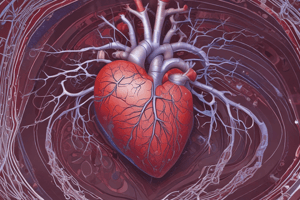Podcast
Questions and Answers
What is the main cause of CAD disease?
What is the main cause of CAD disease?
- Lack of exercise
- High blood pressure
- Diabetes
- Atherosclerosis (correct)
What is the primary function of the coronary arteries?
What is the primary function of the coronary arteries?
- Supplying blood to the brain
- Supplying blood to the liver
- Supplying blood to the lungs
- Supplying blood to the heart (correct)
Which of the following is a symptom of CAD disease?
Which of the following is a symptom of CAD disease?
- Headache
- Fatigue (correct)
- Nausea
- Fever
What is the purpose of a stress test in diagnosing CAD disease?
What is the purpose of a stress test in diagnosing CAD disease?
Which of the following medications is used to lower cholesterol levels in CAD disease?
Which of the following medications is used to lower cholesterol levels in CAD disease?
What is a potential complication of CAD disease?
What is a potential complication of CAD disease?
Flashcards are hidden until you start studying
Study Notes
CAD Disease: Overview
- CAD stands for Coronary Artery Disease
- It is a condition where the coronary arteries, which supply blood to the heart, become damaged or diseased
Causes of CAD Disease
- Atherosclerosis: the buildup of plaque (fat, cholesterol, and other substances) in the coronary arteries, leading to narrowing or blockage
- High blood pressure
- High cholesterol
- Smoking
- Diabetes
- Obesity
- Lack of exercise
- Unhealthy diet
- Family history of CAD
Symptoms of CAD Disease
- Chest pain or discomfort (angina) that occurs when the heart muscle does not get enough oxygen-rich blood
- Shortness of breath
- Fatigue
- Palpitations
- Weakness or dizziness
- Pain or discomfort in the arms, back, neck, jaw, or stomach
Diagnosis of CAD Disease
- Electrocardiogram (ECG or EKG)
- Echocardiogram
- Stress test
- Cardiac catheterization
- Blood tests to check for signs of heart damage or cardiovascular disease
Treatment of CAD Disease
- Lifestyle changes:
- Quit smoking
- Healthy diet
- Regular exercise
- Weight management
- Stress reduction
- Medications:
- Statins to lower cholesterol
- Beta blockers to slow heart rate
- Nitrates to relieve chest pain
- Aspirin to prevent blood clots
- Angioplasty and stenting to open blocked arteries
- Coronary artery bypass grafting (CABG) to bypass blocked arteries
Complications of CAD Disease
- Heart attack (myocardial infarction)
- Heart failure
- Arrhythmias (abnormal heart rhythms)
- Cardiac arrest
- Stroke or transient ischemic attack (TIA or mini-stroke)
CAD Disease: Overview
- CAD stands for Coronary Artery Disease
- Characterized by damaged or diseased coronary arteries, which supply blood to the heart
Causes of CAD Disease
- Atherosclerosis: buildup of plaque in coronary arteries, leading to narrowing or blockage
- High blood pressure increases risk
- High cholesterol levels contribute to plaque buildup
- Smoking damages coronary arteries and increases risk
- Diabetes increases risk due to high blood sugar levels
- Obesity increases risk due to high blood pressure and cholesterol levels
- Lack of exercise contributes to high blood pressure and cholesterol levels
- Unhealthy diet increases risk due to high cholesterol and blood pressure
- Family history of CAD increases individual risk
Symptoms of CAD Disease
- Chest pain or discomfort (angina) due to insufficient oxygen-rich blood to the heart
- Shortness of breath due to reduced blood flow to the lungs
- Fatigue due to reduced oxygen supply to the body
- Palpitations due to abnormal heart rhythms
- Weakness or dizziness due to reduced blood flow to the brain
- Pain or discomfort in the arms, back, neck, jaw, or stomach due to referred pain
Diagnosis of CAD Disease
- Electrocardiogram (ECG or EKG) to measure heart rhythm
- Echocardiogram to visualize heart structure and function
- Stress test to evaluate heart function under physical stress
- Cardiac catheterization to visualize coronary arteries
- Blood tests to detect signs of heart damage or cardiovascular disease
Treatment of CAD Disease
- Lifestyle changes:
- Quitting smoking to reduce damage to coronary arteries
- Healthy diet to reduce cholesterol levels and blood pressure
- Regular exercise to improve cardiovascular health
- Weight management to reduce risk factors
- Stress reduction to minimize cardiovascular stress
- Medications:
- Statins to lower cholesterol levels
- Beta blockers to slow heart rate and reduce blood pressure
- Nitrates to relieve chest pain by dilating coronary arteries
- Aspirin to prevent blood clots and reduce cardiovascular risk
- Angioplasty and stenting to open blocked coronary arteries
- Coronary artery bypass grafting (CABG) to bypass blocked coronary arteries
Complications of CAD Disease
- Heart attack (myocardial infarction) due to blocked coronary arteries
- Heart failure due to reduced heart function
- Arrhythmias (abnormal heart rhythms) due to cardiac damage
- Cardiac arrest due to severe cardiac damage
- Stroke or transient ischemic attack (TIA or mini-stroke) due to reduced blood flow to the brain
Studying That Suits You
Use AI to generate personalized quizzes and flashcards to suit your learning preferences.





